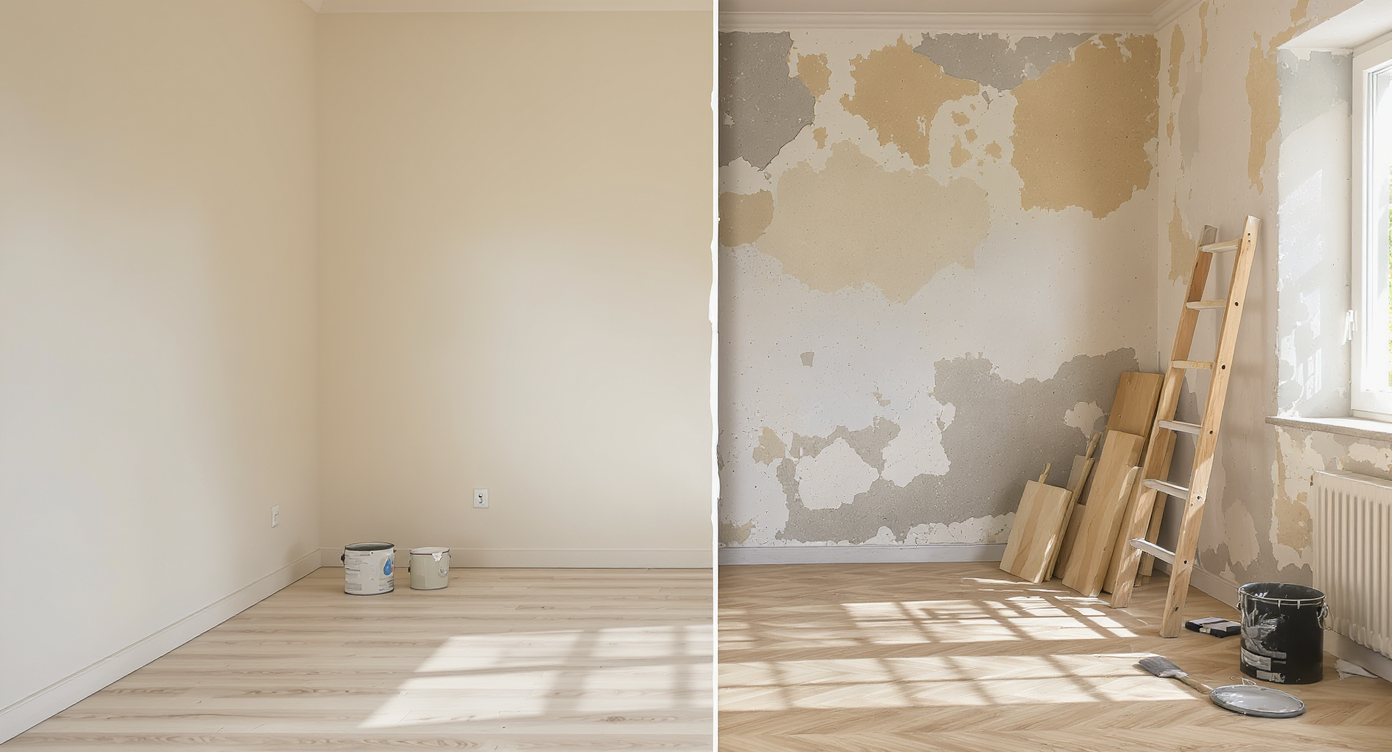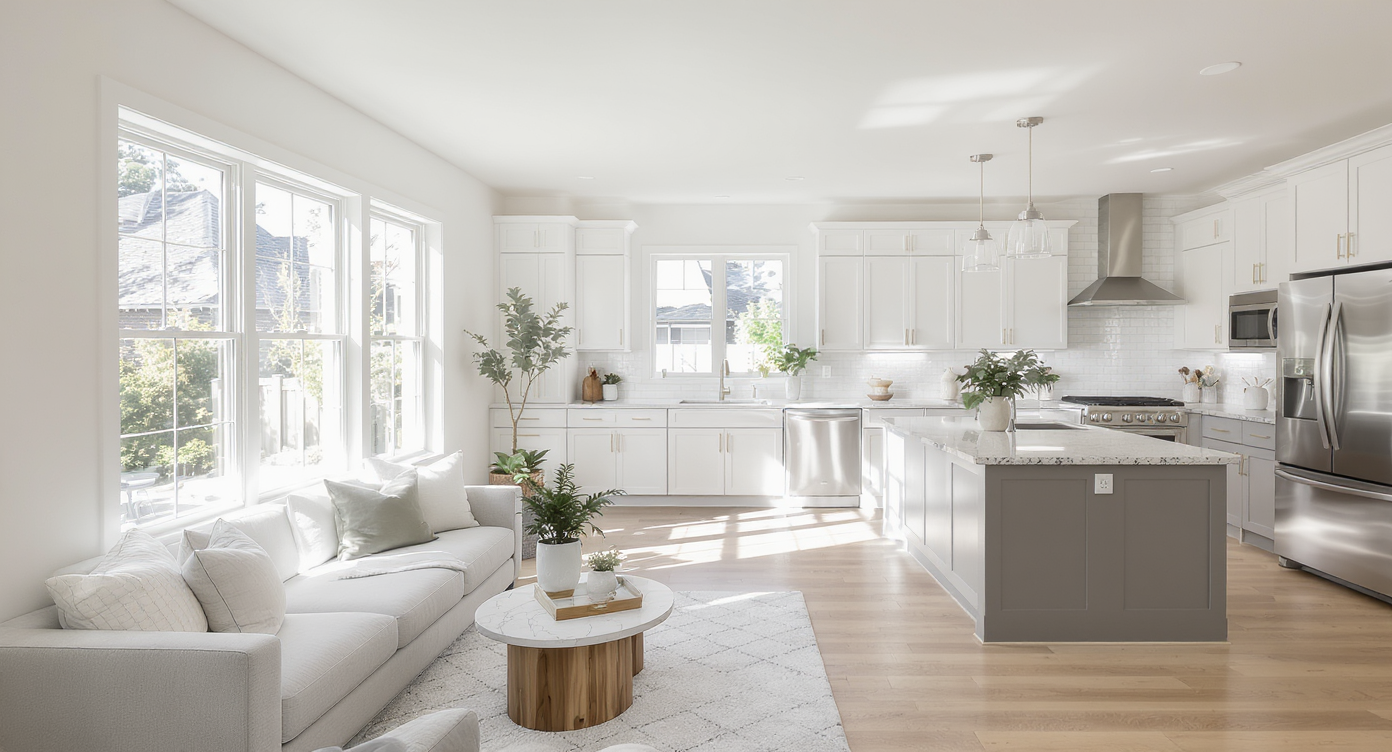TL;DR
Thinking about DIY to boost home resale value? It can pay off for cosmetic updates, but bigger renovations usually require a pro team. For sellers, are DIY renovations worth it for resale depends on scope, craftsmanship, and time-to-market. Focus on low-risk cosmetic updates and leave structural work to licensed pros to avoid value-killing delays. If you need a quick sale, prioritize projects buyers actually notice and that agents say photograph well.
DIY vs. Pro: What Really Moves the Needle

Visualizing the impact of DIY renovations: transforming spaces to maximize resale value.
SEO intro: Weigh DIY renovations vs hiring a contractor to maximize home resale value without blowing the budget or your timeline.
Here’s the thing: DIY renovations can help your listing shine, but not every project is worth your time or risk. Real estate agents consistently note that buyers pay for clean, bright, and move-in ready - not necessarily for the sweat behind the walls. If you’re asking are DIY renovations worth it for resale, the answer depends on scope, quality, and how quickly you need to list.
Short-tail keywords like DIY renovations, home resale value, and renovation budget matter most in the first 100 words for search and for you. Long-tail search intent - which home improvements add value when selling or should I DIY or hire a contractor - points to a clear strategy: tackle low-risk cosmetic updates and outsource complex, code-heavy work to a trustworthy general contractor.
The Essential Verdict: When DIY Renovations Are Worth It
For resale, DIY is usually worth it for cosmetic upgrades under 40 hours and under 1 percent of list price; hire a pro for structural, electrical, or plumbing. Agents often advise sellers to prioritize speed and polished presentation to hit peak market windows.
So, when are DIY renovations worth it for resale? Choose projects with visible impact and minimal failure risk. Think paint, hardware swaps, light fixture updates, caulk and grout refresh, curb appeal, and minor landscaping. These deliver high perceived value because buyers see them first in photos and at the open house.
- High-ROI DIY: interior paint in light warm neutrals, cabinet hardware, LED lighting, front-door paint, basic backsplash, deep clean and regrout, lawn edging. A rule of thumb: keep DIY materials under 1,500 dollars and total time under two weekends for a typical 3-bed home.
- Proceed with caution: tiling a shower, moving plumbing, or rewiring circuits. Code violations or leaks can tank inspections and renegotiations.
Time is money in real estate. If your DIY adds more than 2-4 weeks to the listing date, the cost of delay can outweigh savings. Experts recommend adding a 10-15 percent contingency to any renovation budget and building lead times into the plan - appliances often run 6-12 weeks, windows 12-16 weeks.
Agent insight: in agent surveys, roughly 80 percent say some projects do not add significant value relative to cost when workmanship looks DIY. On the flip side, about 85 percent agree that well-executed medium-difficulty projects - like tiling a floor or installing drywall - can be cost-effective if you have proven skills.
If you’re torn on should I DIY or hire a contractor, split the work. Many sellers demo, patch, and paint while a general contractor handles cabinets, countertops, or permits. This “shared sweat equity” can reduce labor costs by 10-25 percent while preserving professional finish where buyers scrutinize most.
Anecdote
A seller planned to DIY a bathroom “weekend refresh.” Once the vanity came out, hidden rot appeared. They pivoted fast, hired a licensed plumber and carpenter, and focused their own energy on paint and staging. The job finished in 12 days, passed inspection, and the home received multiple offers. The lesson: DIY the visible, hire the critical.
Common Mistakes That Sink ROI
The fastest way to lose ROI is poor planning, bad measurements, and scope creep that extends your timeline beyond the ideal listing window. Designers often advise locking the scope before purchase orders to protect your budget.
- Underestimating time and tools. A weekend tile job can balloon into 40 hours plus 500-1,500 dollars in tools. If a project touches water or wires, budget an extra 30 percent time.
- Skipping permits and inspections. Unpermitted work can derail appraisals and scare buyers. If it changes structure, electrical, plumbing, or egress, pull a permit.
- Bad measurements and orders. Measure thrice, then have someone else verify. Windows ordered wrong can add 12-16 weeks and thousands in carrying costs.
- Scope creep. Start with a faucet, end with a full bath remodel. Write a scope, set a ceiling number, and say no to midstream upgrades.
- Overpersonalizing. Trend-heavy tile or bold built-ins can shrink your buyer pool. For resale, choose timeless finishes and add personality with removable decor.
Pro Tips, Expert Insights, and Real Stories
Plan like a pro: lock decisions early, get three comparable bids, and stage for photos as seriously as you budget for paint. Experts recommend choosing fixtures before rough-in so trades can set heights, valve types, and junction boxes correctly.
- Front-load decisions. Select faucets, lighting, hardware, and tile before framing or rough-in. Changing a valve after tile can triple the cost.
- Get 3 apples-to-apples bids. Specify brand, model, finish, square footage, and timelines. Ask each general contractor for license, insurance, and 3 recent references.
- Use a finish schedule. A one-page list of every finish, SKU, quantity, and lead time prevents mistakes and keeps trades aligned.
- Budget guardrails. Park 10-15 percent as a contingency. For flooring, order 10 percent overage for waste. For tile, plan 15 percent for patterned layouts.
- Pre-inspect your own work. Run a blue-tape walk-through. Check GFCI outlets near water, slope on shower pans, and caulk lines at 1/16-1/8 inch for a pro look.
Anecdotes & Real Stories
A rushed DIY can cost more than hiring out when it delays your sale by a month or more. Agents often advise sellers to price time-to-market above perfection.
- The 6-month kitchen. A homeowner started a “simple” cabinet repaint that snowballed into new doors and a DIY backsplash. What should have been four weeks became six months, missing the spring market. Takeaway: control the scope and set a hard list date.
- The window redo. A couple measured for replacement windows themselves and ordered two units wrong. The re-order took 14 weeks, stalling exterior paint and staging. Takeaway: for items with 8-16 week lead times, pay for a pro measure.
- Live first, then plan. One seller moved in for 60 days, learned the afternoon sun baked the living room, and shifted the budget from a feature wall to window film and layered shades. Takeaway: prioritize fixes that improve daily experience buyers will notice immediately.
- Split the scope, win the weekend. A family hired a licensed plumber to swap a valve and set a new vanity while they handled paint, mirror, and hardware. They spent under 1,200 dollars and sold in 10 days. Takeaway: share sweat equity where it’s safe.
Tools, Inspiration, and Practical Resources
The right tools and visuals cut mistakes and help you present a move-in ready listing faster. Experts recommend mockups to align finishes before ordering.
- Plan and visualize: Use ReimagineHome to test paint colors, cabinet tones, and lighting warmth before you buy. Visual mockups reduce returns and keep jobs on schedule.
- Checklists that save deals: scope sheet, finish schedule with SKUs, permit list, inspection dates, punch list, staging plan, and pro photography date.
- Suggested image alt text and captions for your listing photos:
- Alt: renovated kitchen with updated appliances and warm neutral cabinets - kitchen renovation for resale
- Alt: bright bathroom remodel with new vanity and LED lighting - DIY cosmetic update
- Alt: fresh curb appeal with painted front door and trimmed hedges - boost home resale value
- Buyer-first staging: 3000-4000K LED bulbs, clutter-free counters, fresh white towels, and a green plant per main room. Photograph after 10 a.m. for soft light.
Visualization Scenario
Picture listing photos taken one bright Saturday: a warm white living room with 3500K LEDs, freshly painted trim, a simple olive branch in a clear vase, and a front door in a rich slate blue. The kitchen shows clean grout lines, brushed brass pulls, and counters free of appliances. You can almost hear the open-house chatter. Buyers walk in and think: move-in ready - and they are willing to pay for it.
FAQ: Your Most-Asked DIY Renovation Questions, Answered
Should I DIY or hire a contractor for a kitchen renovation before selling? For resale, DIY small cosmetic updates and hire a contractor for plumbing, electrical, or cabinet installs. This split keeps quality high and your listing timeline tight.
What are the best DIY projects to increase home value quickly? Interior paint, LED lighting swaps, cabinet hardware, deep clean and regrout, new caulk lines, and front-door paint deliver fast, photo-ready impact.
How much contingency budget for renovation should I set? Most designers advise a 10-15 percent contingency. Increase to 20 percent for older homes or projects involving plumbing or electrical.
Which home improvements add value when selling on a tight timeline? Focus on kitchen touch-ups, bath refreshes, curb appeal, and flooring fixes. Avoid structural changes that risk permits, inspections, and delays.
How do I choose a general contractor for renovation? Get three licensed, insured bids with identical scopes, check three recent references, and verify lead times. Insist on a written schedule and clear payment milestones.
Sell Smart, Not Hard
The verdict: DIY renovations are worth it when they are cosmetic, quick, and clean. If a project touches structure, electrical, plumbing, or permits, hire a licensed pro and protect your timeline. Lock the scope, make decisions early, and hold 10-15 percent in contingency so surprises do not hijack your sale.
Want a second set of eyes before you pick a palette or tile? Mock up the space with ReimagineHome, then tackle the right projects with confidence and list on schedule.
.svg)

.svg)














.png)